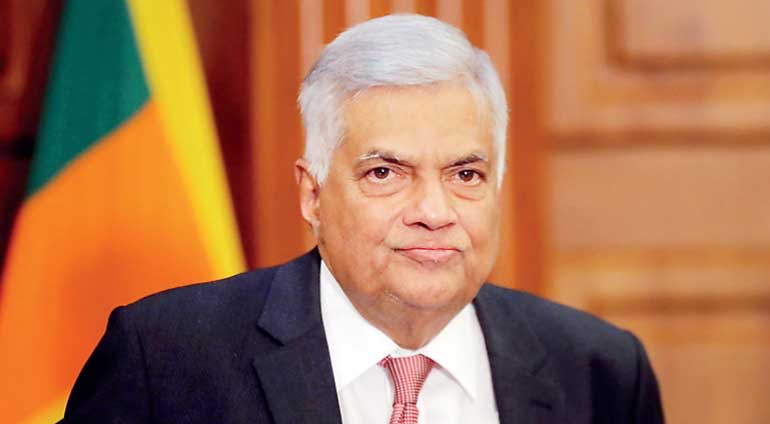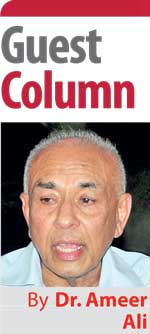Monday Apr 07, 2025
Monday Apr 07, 2025
Friday, 21 October 2022 00:00 - - {{hitsCtrl.values.hits}}

RW’s three frameworks of national policy are interconnected and restructuring the economic framework alone is not sufficient to face the “polycrisis”
 Recently, President Ranil Wickremesinghe (RW) is reported to have said that the country should follow a “national policy” with national council as the platform, and that policy should encompass a national “economic framework”, “social framework” and a “political framework”. What this triple framework would entail and what is expected from the national council in relation to these frameworks have not been made clear yet.
Recently, President Ranil Wickremesinghe (RW) is reported to have said that the country should follow a “national policy” with national council as the platform, and that policy should encompass a national “economic framework”, “social framework” and a “political framework”. What this triple framework would entail and what is expected from the national council in relation to these frameworks have not been made clear yet.
However, the content and objective of the economic framework could be gleaned from RW’s earlier pronouncements on transforming the economy and country to developed status and First World nation respectively, by means of an innovative export-oriented growth mechanism. Given the current financial bankruptcy and burden of debt, such a transformation would have to be funded either through massive injections of foreign investment or increased generosity from international aid agencies like IMF, WB and ADB or direct borrowing from the international credit market. None of these options look promising given the probability of another recession threatening to engulf more than a third of world economies.
IMF predicts that world growth rate would plunge from 6% in 2021 to 3.2% in 2022 and 2.7% in 2023. Even China, which experienced an impressive 8% growth in 2021 is due to face only 3.2% in 2022 and is expected to perform worse in 2023. Average rate of inflation, which hit 8.8% last year is expected to come down slightly to 6.5% by the end of this year in response to increasing interest rates by central banks. Even so, higher interest rate alone is not sufficient to eliminate inflation, because it is now being driven from the supply side of the equation. Escalation of the war in Europe, rising nuclear tension in Taiwanese Strait, OPEC cut in oil production and frequency of environmental disasters are creating supply constraints leading to breakdown in supply chains, higher commodity prices, falling demand and low growth.
Given this gloomy picture, dreaming of transforming Sri Lanka into an export-oriented miracle looks increasingly problematic to say the least. It is time the Government concentrates more in utilising the internal strength of the economy and create surpluses so that exports could become a contributory channel to ease domestic difficulties. A planned approach towards this goal should be undertaken, which is beyond the competence of RW’s National Council.
The country is in this parlous state of affairs because too much resources were wasted on too many glamorous projects leaving less to flow into more productive areas. GDP figures do not reveal this mismanagement and other unlawful leakages from public wealth. Yet, increase in GDP was the only yardstick used to include Sri Lanka among the family of upper middle-income countries. What was worse, the unaccountability of those who were responsible for this misuse and were allowed to roam free and continue as political leaders furthering their economic crime. The result was financial bankruptcy, massive foreign debt, economic devastation, which ultimately forced the same yardstick to downsize the economy first to lower middle-income and now low-income status. What an achievement in reverse! At least now let us cut the cloth to fit the suit.
RW’s triple framework is therefore necessary but requires demolition of the old ideological mould of ethnonationalist majoritarianism that shaped the current political and social frameworks, which in turn shaped the economic framework. It is the need of this demolition that shaped the essence of Aragalaya’s call for systemic change. RW’s National Council is certainly not the platform to initiate that change. That council consists of rejects who RW found unfit to be in the cabinet and unsuitable to be appointed as state ministers. With factional allegiance and hidden political agendas any discussion among them on crucial would only end in dogs’ breakfast.
The task needs a new team of leaders that should include within it men and women from the Aragalaya generation too, but mandated by the voting public. RW is not only silent on this alternative, but with his short-term popularity gained through enabling a new normalcy amidst increasing poverty, has decided to eliminate the threat from Aragalaya and start focusing the nation’s attention on electoral reforms instead. An obvious implication of this strategy is to give enough time for his Rajapaksa patrons to rebuild their shattered image. Mahinda’s characteristic visit to Buddhist temples to receive blessing from the saffron battalion has started.
To come back to the economy, a new and realistic framework for growth and development relying primarily on the internal strength of domestic sectors is an immediate need. To put it bluntly, based on the level of development reached so far and the stock of real assets the country has, which includes basically its volume of natural resources and a literate and skilled population, an intersectoral growth plan should be designed by a team of independent economists with targets to be reached within a certain time limit. This is not to argue for a closed economy via reintroduction of the defunct ISI strategy. Instead, it is a plea for realism or pragmatism in light of the gathering clouds of a global recession, which may not disappear at least until the end of 2023 and could extend well into 2024.
The natural resources of the country, the collective synergy of its plural society with its diverse skills, experience and knowledge are the real wealth of this nation. While the first had been misused the second left underutilised. That underutilisation is primarily due to social disconnections created by the aforementioned ideology of ethnonationalist majoritarianism. Thus, RW’s three frameworks of national policy are interconnected and restructuring the economic framework alone is not sufficient to face the “polycrisis”.
According to one academist, a staggering 45% of the population is living in poverty at the moment. This poverty cannot be driven out through IMF directed tight monetary and fiscal policies. It is the limitless rise in cost of living fed by inflation that is pushing more and more households into the poverty trap. That inflation is not demand pull but supply push. The lasting solution therefore is to increase the supply of goods in the market and removing criminal profiteering by a politically connected mafia, monopolists and hoarders. That is not possible under the current political framework within which RW’s National Council is set to function.
The spirit of Aragalaya is not dead although few of its leaders and hundreds of participants are languishing in RW’s jails. A systemic change is unavoidable, and the global setting is adding a new momentum for its need. Unless RW understands this, the next phase of Aragalaya may turn out to be bloody.
(The writer is attached to Murdoch Business School, Murdoch University, Western Australia.)
Discover Kapruka, the leading online shopping platform in Sri Lanka, where you can conveniently send Gifts and Flowers to your loved ones for any event including Valentine ’s Day. Explore a wide range of popular Shopping Categories on Kapruka, including Toys, Groceries, Electronics, Birthday Cakes, Fruits, Chocolates, Flower Bouquets, Clothing, Watches, Lingerie, Gift Sets and Jewellery. Also if you’re interested in selling with Kapruka, Partner Central by Kapruka is the best solution to start with. Moreover, through Kapruka Global Shop, you can also enjoy the convenience of purchasing products from renowned platforms like Amazon and eBay and have them delivered to Sri Lanka.
Discover Kapruka, the leading online shopping platform in Sri Lanka, where you can conveniently send Gifts and Flowers to your loved ones for any event including Valentine ’s Day. Explore a wide range of popular Shopping Categories on Kapruka, including Toys, Groceries, Electronics, Birthday Cakes, Fruits, Chocolates, Flower Bouquets, Clothing, Watches, Lingerie, Gift Sets and Jewellery. Also if you’re interested in selling with Kapruka, Partner Central by Kapruka is the best solution to start with. Moreover, through Kapruka Global Shop, you can also enjoy the convenience of purchasing products from renowned platforms like Amazon and eBay and have them delivered to Sri Lanka.